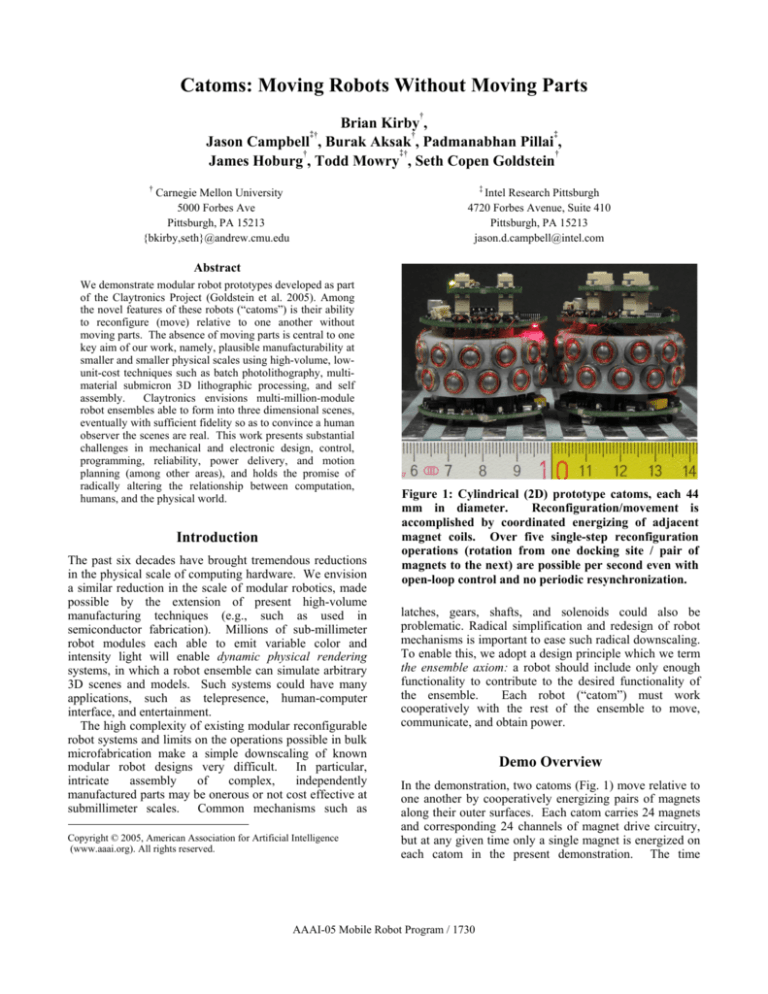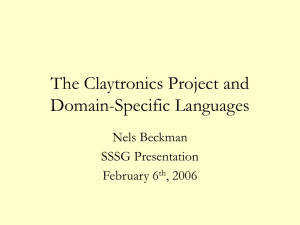
Catoms: Moving Robots Without Moving Parts
†
Brian Kirby ,
‡†
‡
†
Jason Campbell , Burak Aksak , Padmanabhan Pillai ,
‡
†
†
†
James Hoburg , Todd Mowry , Seth Copen Goldstein
†
‡
Carnegie Mellon University
5000 Forbes Ave
Pittsburgh, PA 15213
{bkirby,seth}@andrew.cmu.edu
Intel Research Pittsburgh
4720 Forbes Avenue, Suite 410
Pittsburgh, PA 15213
jason.d.campbell@intel.com
Abstract
We demonstrate modular robot prototypes developed as part
of the Claytronics Project (Goldstein et al. 2005). Among
the novel features of these robots (“catoms”) is their ability
to reconfigure (move) relative to one another without
moving parts. The absence of moving parts is central to one
key aim of our work, namely, plausible manufacturability at
smaller and smaller physical scales using high-volume, lowunit-cost techniques such as batch photolithography, multimaterial submicron 3D lithographic processing, and self
assembly.
Claytronics envisions multi-million-module
robot ensembles able to form into three dimensional scenes,
eventually with sufficient fidelity so as to convince a human
observer the scenes are real. This work presents substantial
challenges in mechanical and electronic design, control,
programming, reliability, power delivery, and motion
planning (among other areas), and holds the promise of
radically altering the relationship between computation,
humans, and the physical world.
Introduction
The past six decades have brought tremendous reductions
in the physical scale of computing hardware. We envision
a similar reduction in the scale of modular robotics, made
possible by the extension of present high-volume
manufacturing techniques (e.g., such as used in
semiconductor fabrication). Millions of sub-millimeter
robot modules each able to emit variable color and
intensity light will enable dynamic physical rendering
systems, in which a robot ensemble can simulate arbitrary
3D scenes and models. Such systems could have many
applications, such as telepresence, human-computer
interface, and entertainment.
The high complexity of existing modular reconfigurable
robot systems and limits on the operations possible in bulk
microfabrication make a simple downscaling of known
modular robot designs very difficult. In particular,
intricate
assembly
of
complex,
independently
manufactured parts may be onerous or not cost effective at
submillimeter scales. Common mechanisms such as
Copyright © 2005, American Association for Artificial Intelligence
(www.aaai.org). All rights reserved.
Figure 1: Cylindrical (2D) prototype catoms, each 44
mm in diameter.
Reconfiguration/movement is
accomplished by coordinated energizing of adjacent
magnet coils. Over five single-step reconfiguration
operations (rotation from one docking site / pair of
magnets to the next) are possible per second even with
open-loop control and no periodic resynchronization.
latches, gears, shafts, and solenoids could also be
problematic. Radical simplification and redesign of robot
mechanisms is important to ease such radical downscaling.
To enable this, we adopt a design principle which we term
the ensemble axiom: a robot should include only enough
functionality to contribute to the desired functionality of
the ensemble.
Each robot (“catom”) must work
cooperatively with the rest of the ensemble to move,
communicate, and obtain power.
Demo Overview
In the demonstration, two catoms (Fig. 1) move relative to
one another by cooperatively energizing pairs of magnets
along their outer surfaces. Each catom carries 24 magnets
and corresponding 24 channels of magnet drive circuitry,
but at any given time only a single magnet is energized on
each catom in the present demonstration. The time
AAAI-05 Mobile Robot Program / 1730
required for a “step reconfiguration”, from one pair of
magnets to an adjacent pair, is on the order of 100ms.
Power to operate electronics and magnets is provided
via pickup feet on the bottom of each catom. These feet
make contact with conductive strips in the table, where
strips connect alternately to +15VDC or ground. On-board
rectification circuitry resolves the polarity of the power
connections and an on-board DC/DC converter on each
catom efficiently transforms the high voltage available
from the table to 5VDC to power logic components. (The
magnets are driven with unregulated power directly from
the rectifiers.)
Each magnet is controlled by an H-bridge circuit, the Hbridges are in turn driven by outputs from serial-inparallel-out shift registers, finally, the shift registers are
loaded by a microcontroller. This approach increases the
current available for driving the transistors in each Hbridge and reduces the size/pin-count of the
microcontroller package.
Future prototypes will also incorporate a 32-bit
microprocessor for high-level control, wireless (broadcast)
and
optical
(nearest-neighbor)
communications
subsystems, and wired (unary) interconnects between
catoms for use in power sharing via “virtual wires”
(Campbell et al. 2005).
Related Work
A number of modular robotics efforts have focused on
movement and locomotion (e.g., Yim et al. 1997; Murata
et al. 1994;). The approaches have been frequently limited
by slow docking/undocking speeds due to the need to
precisely position modules before successful mechanical
engagement. Others researchers have sought to apply
modular robotics to shape formation (e.g., Murata et al.
2002; Winkler et al. 2004; Yim et al. 1997; Suh et al.
2002). These approaches have suffered from the large
physical size of the modules involved, and relatively small
numbers of modules envisioned (typically, thousands),
which limits the spatial fidelity with which shapes can be
resolved. Our work takes as a base assumption the need to
support millions of cooperating catoms which should be
capable of extremely high speed reconfiguration (i.e., no
multiphase alignment procedures).
A further distinction in our work is the focus on radical
simplification to the extent that moving parts and gendered
and multiconductor connectors are entirely eliminated.
Our module design is even less complex than prior work
which, for similar reasons, has also aimed at module
simplicity (e.g., Yim et al. 2000; Rus and Vona 1999).
References
Campbell, J., Pillai, P., Goldstein, S. 2005. The Robot is the
Tether: Active, Adaptive Power Routing for Modular Robots With
Unary Inter-robot Connectors. Forthcoming. (please see
www.cs.cmu.edu/~claytronics for an updated citation)
Goldstein, S., Mowry, T., Kirby, B., et al. 2005. Claytronics.
Forthcoming. (please see www.cs.cmu.edu/~claytronics for an
updated citation)
Murata, S., Kurokawa, H., Kokaji, S. 1994. Self-assembling
machine. In Proc. IEEE ICRA, pp. 441–448.
Murata, S., Yoshida, E., Kamimura, A., Kurokawa, H., Tomita,
K., and Kokaji, S. 2002. M-tran: Self-reconfigurable modular
robotic system. IEEE/ASME Trans. on Mechatronics, 7(4).
Rus, D. and Vona, M. 1999. Self-reconfiguration planning with
compressible unit modules. In Proc. IEEE ICRA.
Suh, J., Homans, S. B., and Yim, M. 2002. Telecubes:
mechanical design of a module for a self-reconfigurable robotics.
In Proc. IEEE ICRA, pp. 4095–4101.
Winkler, M., Jorgensen, Ostergaard, E. H., and Lund, H. H. 2004.
Modular Atron: Modules for a self-reconfigurable robot.
Yim, M., Duff, D., and Roufas, K. 2000. Polybot: a modular
reconfigurable robot. In Proc. IEEE ICRA, pp. 514–520.
Yim, M., Lamping, J., Chase, E. M. J. 1997. Rhombic
dodecahedron shape for self-assembling robots. Technical Report
SPL TR P9710277, Xerox PARC.
Acknowledgements
This work was supported in part by Intel, CMU, Butler
Winding Co., NSF grant CNS-0428738, and DARPA
Contract N66001-04-1-8931.
AAAI-05 Mobile Robot Program / 1731










